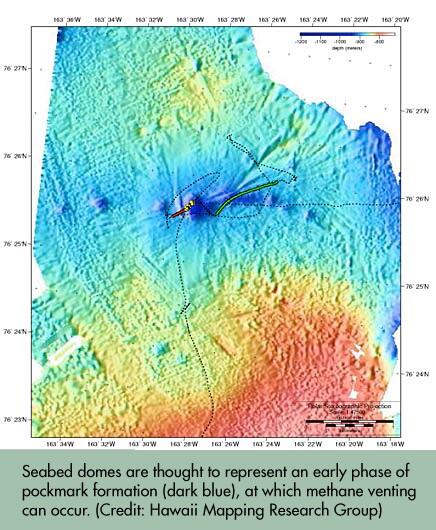Building sea-floor features in the lab
DOI: 10.1063/PT.4.0414
By Rachel Berkowitz
The sea floor has its own map of topographical features. Domes, pockmarks, and mud volcanoes may be generated when gaseous methane dissociates from its hydrate form and accumulates in soft clay-bearing sediments on the ocean floor. The accumulated gas can cause the sediment to deform into domes 10 to 1000 m in diameter. Just how much pressure it takes to form a dome is important to understand because the presence of domes indicates pressurized gas and thus a threat to sea-floor drilling.
Until now, all understanding of dome formation has been via observational and qualitative analyses. But a Canadian team has taken the problem into the laboratory and produced the first prediction of the magnitude of gas pressure needed to create seabed domes.
The researchers created domes in plates of gelatin and natural sediments by pressurizing the materials from below via an air pump and seeing whether the deformation of the sediment layers was consistent with standard elastic models.

It turns out that the experiments were, indeed, consistent with elastic thin-plate mechanics: seabed sediments, as modeled in the lab by clayey sediments or gelatin, can be treated as an elastic single-phase medium. Thin-plate mechanics requires plate width to be large and deflection to be small relative to plate thickness. That’s interesting because plate-bending theory was developed for stiff engineering materials such as steel, not soft materials like unlithified sediment and gelatin.
The study, published online
Thicker regions of sediment are much more resistant to deformation, however, and higher pressures can build up. But increasing ocean temperatures will likely cause extensive dissociation of gas hydrates within the seabed. That leads to a decrease in thickness of the gas-hydrate stability zone (the cemented sediment layer) and, in turn, to reduced stiffness. Reduced stiffness promotes further dome formation, tensile fracture failure, and pockmarks, which can then release free gas.
Demonstrating the suitability of elastic thin-plate mechanics to describe dome formation provides a new tool for predicting sea-floor stability and the associated dangers to sea-floor drilling.